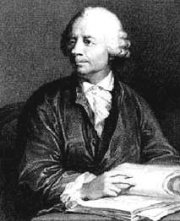Online Encyclopedia
Leonhard Euler

Leonhard Euler (April 15, 1707 - September 18, 1783) (pronounced "oiler") was a Swiss mathematician and physicist. He is considered (together with Archimedes, Gauss, and Newton), to be one of the greatest mathematicians. Leonhard Euler was the first to use the term "function" (defined by Leibniz - 1694) to describe an expression involving various arguments; ie: y = F(x). He is credited with being one of the first to apply calculus to physics.
Born and educated in Basel, he was a mathematical child prodigy. He worked as a professor of mathematics in Saint Petersburg, later in Berlin, and then returned to Saint Petersburg. He holds the world record for most prolific mathematician of all time, his collected work filling 75 volumes. He dominated eighteenth century mathematics and deduced many consequences of the newly invented calculus. He was completely blind for the last seventeen years of his life, during which time he produced almost half of his total output.
Euler was deeply religious throughout his life. However, the widely told anecdote that Euler challenged Denis Diderot at the court of Catherine the Great with "Sir, (a+b)n/n = x; hence God exists, reply!" is false.
The asteroid 2002 Euler is named in his honour.
| Contents |
Discoveries
Euler, with Daniel Bernoulli, established the law that the torque on a thin elastic beam is proportional to a measure of the elasticity of the material and the moment of inertia of a cross section, about an axis through the center of mass and perpendicular to the plane of the couple.
He also deduced the Euler equations, a set of laws of motion in fluid dynamics, directly from Newton's laws of motion. These equations are formally identical to the Navier-Stokes equations with zero viscosity. They are interesting chiefly because of the existence of shock waves.
He made important contributions to the theory of differential equations. In particular, he is known for creating a series of Euler approximations which are used in computational mechanics . The most famous of these approximations is known as Euler's method.
In number theory he invented the totient function. The totient φ(n) of a positive integer n is defined to be the number of positive integers less than or equal to n and coprime to n. For example, φ(8) = 4 since the four numbers 1, 3, 5 and 7 are coprime to 8.
In mathematical analysis, it was Euler who synthesised Leibniz's differential calculus with Newton's method of fluxions.
He established his fame in 1735 by solving the long-standing Basel problem:
 ,
,
where ζ(s) is the Riemann zeta function.
He also showed the usefulness, consistency, and simplicity of defining the exponent of an imaginary number by means of the formula
This is Euler's formula, which establishes the central role of the exponential function. In essence, all functions studied in elementary analysis are either variations of the exponential function or they are polynomials. What Richard Feynman called "The most remarkable formula in mathematics" (more commonly called Euler's identity) is an easy consequence:
In 1735, he defined the Euler-Mascheroni constant useful for differential equations:
He is a co-discoverer of the Euler-Maclaurin formula which is an extremely useful tool for calculation of difficult integrals, sums and series.
Euler wrote Tentamen novae theoriae musicae in 1739 which was an attempt to combine mathematics and music; a biography comments that the work was "for musicians too advanced in its mathematics and for mathematicians too musical".
In economics, he showed that if each factor of production is paid the value of its marginal product, then (under constant returns to scale) the total income and output will be completely exhausted.
In geometry and algebraic topology, there is a relationship called Euler's Formula which relates the number of edges, vertices, and faces of a simply connected polyhedron. Given such a polyhedron, the sum of the vertices and the faces is always the number of edges plus two. i.e.: F - E + V = 2. The theorem also applies to any planar graph. For nonplanar graphs, there is a generalization: If the graph can be embedded in a manifold M, then F - E + V = χ(M), where χ is the Euler characteristic of the manifold, a constant which is invariant under continuous deformations. The Euler characteristic of a simply-connected manifold such as a sphere or a plane is 2. A generalization of Euler's formula for arbitrary planar graphs exists: F - E + V - C = 1, where C is the number of components in the graph.
In 1736 Euler solved a problem known as the seven bridges of Königsberg, publishing a paper Solutio problematis ad geometriam situs pertinentis which was the earliest application of graph theory or topology.
Quotes
- "Read Euler: he is our master in everything." —Pierre-Simon Laplace
Further reading
- Dunham, William (1999). Euler: The Master of Us All, Washington: Mathematical Association of America. ISBN 0-88385-328-0.
- Simmons, J. (1996). The giant book of scientists -- The 100 greatest minds of all time, Sydney: The Book Company.
See also
- Mathematician
- Physicist
- Mathematical constants
- Complex number
- Euler's conjecture
- Euler's disk
- Euler's rotation theorem
- Euler number
- Euler's totient function
- Child prodigy
External link
- MacTutor biography of Euler http://www-history.mcs.st-andrews.ac.uk/history/Mathematicians/Euler.html



